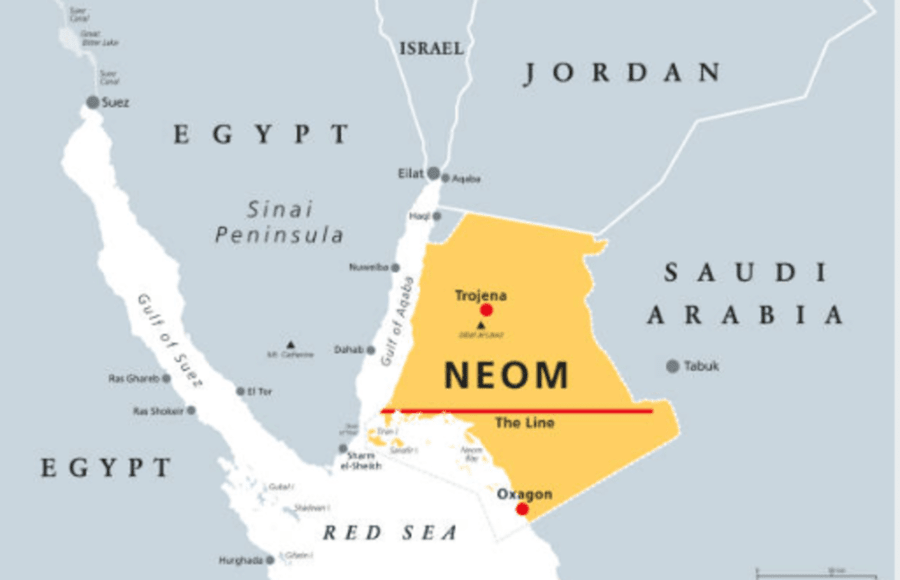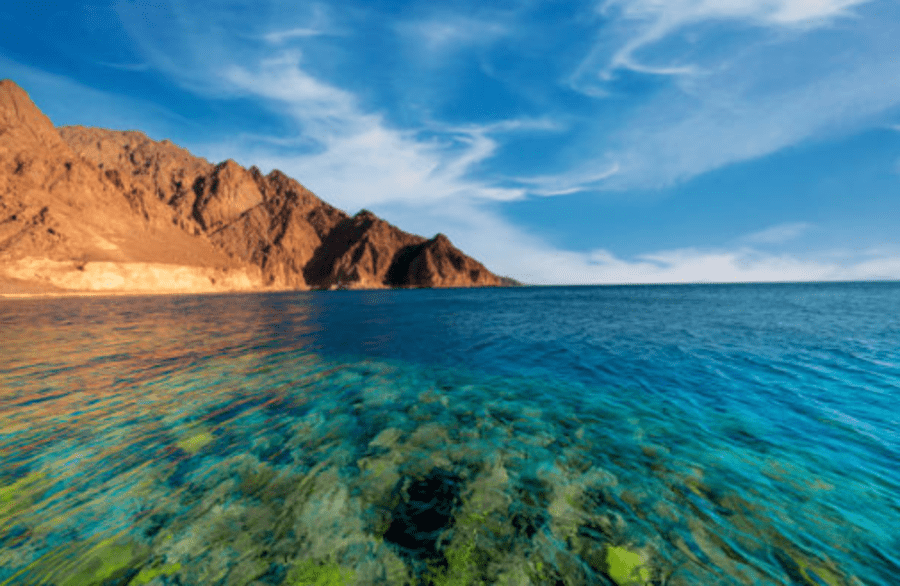An Arabic nation in the middle of the desert ventured to build a sustainable construction project called Neom, capturing the world’s attention. NEOM is Crown Prince Mohammad bin Salman‘s dream project. He wants to transform his country towards sustainability. The crown prince constructed his project in the Tabuk province of Saudi Arabia, bordering the Red Sea.

Neom, the sustainable construction project located on the map of Saudi Arabia.
Source: iStock.
What Does This sustainable Construction project Entail?
The Line is planned to be a long, linear city. It’s planned to be 170 kilometres long, running east to west across the NEOM region. It would house about nine million people while featuring two parallel, 500-meter-high skyscrapers with mirrored facades. It would include The Oxagon is an octagon-shaped port city on the Red Sea’s southern edge. Builders designed it to be the world’s largest floating structure and will serve as a port and logistics hub. Also, there is the Trojena, which is a ski resort in the desert. This 60-square-kilometre resort offers year-round skiing and will host the 2029 Asian Winter Games. Finally, there is Sindalah which is an island resort within the Red Sea, catering to the yachting community. It boasts an 86-berth marina and several hotels.
But, will NEOM, the futuristic city planned for Saudi Arabia, that promises a beacon of sustainability, truly be a model for a sustainable construction project for a climate-friendly future or remain just as a mirage in the desert? Let’s delve deeper.
Ambitions of this Sustainable Construction Project
- Renewable Energy Powerhouse: Among its tall claims, NEOM stands to be a mega structure that will not depend on any fossil fuel-powered energy source, and is a step in the right direction for a country rich in oil reserves. Indeed, renewables, like wind and solar, will power NEOM, reducing its carbon footprint.
- Clean Water Solutions: Desalination plants are the only way Arabian countries are feeding their populations and industries with water. However, these plants come with their own share of negative impacts on the marine ecosystem. At NEOM, zero-liquid discharge technology is planned. As a result, this minimises environmental impact, which is a step in the right direction.
- Vertical Farming Oasis: Indoor farming promises food security and reduces reliance on water-intensive agriculture. Farming practices within the region also reduce the carbon footprint of agricultural produce thus helping the residents have fresh food which is carbon neutral as well.

Leyja NEOM An Oasis of Serenity on the Gulf of Aqaba.
Source: iStock.
Challenges, Controversies, and Concerns
The reality of building such a sustainable construction project in the middle of a desert comes with its own set of challenges. What particularly strikes me is the embodied carbon of the construction. Indeed, the construction phase itself could generate massive CO2 emissions, negating some environmental benefits.
- Impact on Wildlife: The mirrored facade’s effect on bird migration and the disruption of natural habitats remain unclear. True sustainability and thrivability means the builders will need to assess the impacts on wildlife.
- The Linear structure: Summertimes could be pretty difficult for the areas surrounding the line, as the mirrored walls would reflect sun rays and create two heat zones, heating up things in and around the line. The Line, since it will not be shaded, the architects have the humongous task of providing efficient cooling to protect its residents inside the line. Energy-efficient ventilation systems need to be installed to protect the customers from the heavy Saudi heat.
- Intersectionality: Will the ultra-rich be the only ones who will be able to afford living in this futuristic city? That is another aspect of thrivability that is missing in the NEOM building plan.
- Population Growth: The city’s design seems limited to a specific population. How will it adapt to future growth? Will it keep elongating in a linear structure? Is there space to extend infinitely, or is the line destined only for the first few billionaires who can afford a home here?
- Economic Feasibility: Securing funding for this ambitious project remains a hurdle. However, the crown prince, while having funded the project to a certain extent, hopes to tap sovereign wealth funds, globally, to invest about 600 billion riyals and maybe some in an initial public offering which is expected to begin in 2024.
How Neom Can Inspire Future Sustainable Construction Projects?
It sure is a good concept, but additional elements need to be addressed to make this truly sustainable and thrivable. To begin with, by thinking about social equity and inclusivity, future buildings should prioritise affordable housing, inclusive design, and accessible public spaces. Given the crisis, various climate adaptation measures, like flood-resistant design and heat mitigation, need to fall in place. A very important theme would be a regenerative economy, which incorporates wastewater treatment, sustainable procurement, and measures beyond recycling bins. Behaviour change programs should also be in place to cultivate this sustainability culture among residents. Additionally, initiatives such as educational workshops and community events can reinforce these efforts.
Achieving the United Nations Sustainable Development Goals (SDGs) and how they link to The Issue Of Climate Change
The United Nations Sustainable Development Goals, or SDGs, provide a comprehensive framework for addressing global challenges, which are directly and indirectly linked to climate change.
- SDG3: Good health and well-being. NEOM’s design eliminates polluting transport. They intend to incorporate electric-powered trains. This reduces the air pollution and promotes good health among its residents.
- SDG7: Affordable and clean energy. In fact, the transmission and usage of clean energy is in accordance with the SDG7.
- SDG11: Sustainable cities and communities. The whole NEOM structure is built on sustainable cities and communities principles. These communities are self-reliant, safe, pollution-free, enabling healthy living.
- SDG13: Climate action. The design of NEOM is based on principles of mitigating climate change.
A Thrivable Framework
To ensure sustainability, buildings which combat climate change and incorporate sustainable attributes that empower the residents is the need of the hour. So also, is the need to know about other aspects of sustainability. Our not-for-profit organisation The THRIVE project, aims to advacate about sustainability, and push the boundaries of sustainability using the innovative THRIVE framework. You can read more about the work that we do by clicking the following links.






















